From the northern plains to the Alps and the Pyrenees, via the west coast and the eastern border, Vauban's fortifications are everywhere: they draw tangible borders and form a real "iron belt" protecting the kingdom. Vauban constantly adapted to all the sites, all the relief and all the diversity of the French landscape, with a great deal of pragmatism. For example, he used local building materials as much as possible to ensure that the buildings were as solid as possible.
The serial property "Fortifications of Vauban" consists of the following components:
- the citadel of Arras: a new citadel on the plain of the first system
- the citadel, the urban enclosure and Fort Griffon of Besançon: adaptation to a dominated meander site - Vauban's second system of bastioned towers
- the urban enclosure and the Pâté and Médoc forts in Blaye/Cussac-Fort-Médoc: locking in an estuary and adaptation to pre-existing works (Citadel of Blaye), oval defensive tower (Fort Pâté), gates and hydraulic defences (Fort Médoc)
- the urban enclosure, the Salettes, Trois-Têtes, Dauphin and Randouillet forts, the Y communication and the Asfeld bridge at Briançon: total adaptation to the site/absence of a system. Staggered defences flanking each other throughout the height and exceptional quality of the fortified landscape thus created
- the gilded tower of Camaret-sur-Mer: a fort at the sea with a low battery and a gorge tower
- the new town of Longwy: one of Vauban's nine new towns, whose interior buildings and town planning have been preserved and which is preserved in its environment
- the stronghold of Mont-Dauphin: creation of a stronghold of the first mountain system
- the citadel and enclosure of Mont-Louis: fortification of the first system adapted to the mountain, integrating a very fine group of military buildings
- the new town of Neuf-Brisach: a synthesis ensemble, both in terms of urban planning and as the only example of the third system
- the enclosure and citadel of Saint-Martin-de-Ré: citadel and urban enclosure in an island site
- the observatory towers of Saint-Vaast-la-Hougue / Tatihou: the third type of Vauban sea tower, after the compact fort (Pâté) and the low battery tower (Camaret-sur-Mer)
- the enclosure, the Liberia fort and the Cova Bastera in Villefranche-de-Conflent: advanced mountain fort, adaptation of a medieval mountain enclosure
Whether it is a seaside tower designed to defend the access to a port, a stronghold built from scratch in the mountains, or an urban enclosure composed of bastioned towers, these twelve major sites constitute the best examples of this intellectual work, built in places chosen and sublimated by the engineer.

